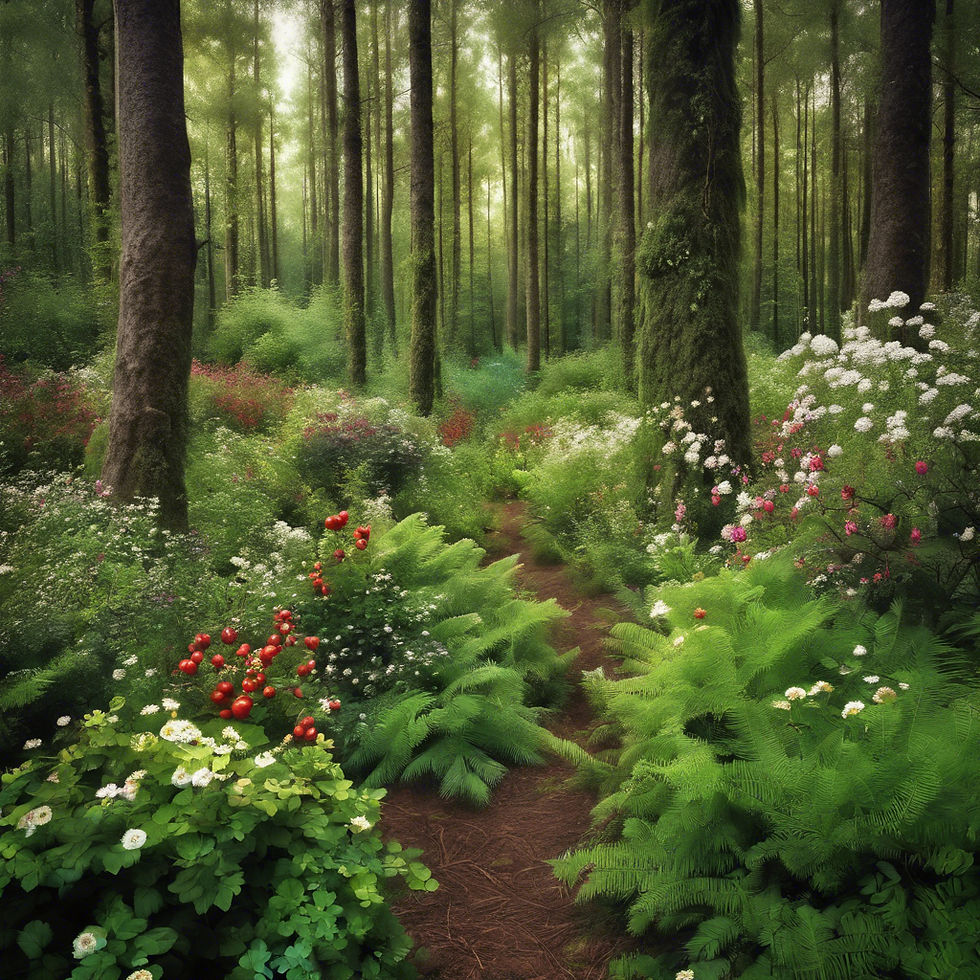Food Forest: Create Your Ideal Ecosystem
- Francis NoVe
- Feb 7
- 5 min read
We are about to introduce you to a fascinating world, that of nourishing forests. Imagine picking your fruits and vegetables directly from a generous and abundant nature! This initiatory journey will allow you to understand the main advantages of respectful, sustainable agriculture, synonymous with abundant biodiversity.

Choosing Trees
Wise choices
Making the right choice of trees for your dream food forest is essential. This decision should not be taken lightly, as it determines not only the aesthetics of your green space but also its performance and longevity. First of all, you must take into account the specific characteristics of each tree: their height once mature, their specific needs in terms of water and light, as well as their compatibility with the local climate and the nature of the soil available on your property. Basically, two main avenues are available to you: fruit trees or nut trees. Many in the second category release a substance called juglone that harms many understory plants. There is therefore greater diversity possible in the first category.
The importance of maintenance
Regular care is another crucial aspect of creating a thriving food forest. It’s not just about occasional cleaning or pruning of dead branches – it’s a holistic practice that also includes enriching the soil, combating diseases and pests, and carefully monitoring the microclimate created by your cherished trees. Know that proper care not only ensures healthy growth, but also allows trees to produce abundantly year after year.
Nitrogen fixers: your unsuspected allies
Never dismiss the idea of introducing into your green haven plant species known as nitrogen fixers such as honey locusts or black locusts. These remarkable plants have the unique ability to capture atmospheric nitrogen - an essential element for plant growth - and convert it into a form that can be used by other plants. By incorporating them and practicing the "chop and drop" technique, you naturally and quickly enrich your soil while creating mulch and therefore increasing the overall productivity of your food forest.

Shrub understory
Choosing well the shrubs
In the vastness of our food forest, the informed choice of shrubs is crucial. Their specific needs and mesurments must be considered: some prefer to nestle in a shady corner, away from the blazing sun; while others have a predilection for direct light. Their ability to flourish and enrich our forest depends largely on these conditions.
Maintenance: A vigorous necessity
Plant maintenance should never be neglected. Some are invasive, especially raspberry bushes and blackcurrants, which require increased monitoring so that they do not dominate their more fragile companions. The size of each shrub has its own specificities and you will need to find out. Regularly prune superfluous or diseased branches to maintain the natural balance between all the inhabitants of your enchanted grove.

Fascinating climbing shrubs
Let's close with this little-known wonder that are climbing shrubs that produce fruit! These allied plants require stakes (perhaps consider your nitrogen-fixing trees that you prune drastically) and greatly multiply the yield per square surface. By judiciously selecting your climbing plants - such as the grapevine or the Siberian kiwi - you not only bring color and variety to your undergrowth, while filling all the ecological niches of the ecosystem.
Each decision we make contributes to the living picture that is our food forest. Be aware, however, that this category of plants will give it a very full appearance and more cleaning and maintenance work will be necessary.
Under plant story
The magic of annuals
In our dream food forest, annual plants occupy a prominent place. They not only offer a unique diversity in terms of species and colors, they bring an unparalleled dynamism to the undergrowth. Thanks to their rapid growth, these plants are able to promptly reward your efforts. Let's think of calendula, borage, nasturtium and all the annual vegetables and herbs that can also be introduced here and there following the inspiration of the gardener.
Emerald of Perennial Vegetables and Fruits
Beyond simple ephemeral flowers, we are fortunate to introduce perennial vegetables into the plant architecture of the forest understory. These green gems provide a sustainable and perpetual source of nutrients essential to human health while enriching the biodiversity of the forest floor. Asparagus, perennial onions, strawberries and chives are perhaps the most popular, but the list in this category includes several lesser-known plants that can be invited to your table.

Flowering perennials
No one can resist the alluring call of flowering perennials that dot the green carpet of the understory with their seasonal bursts of color. More than just being pleasing to the eye, these perennial blooms encourage pollination and often serve as habitat for a multitude of beneficial insects. In addition, they can also be invited to your table in the form of edible flowers (monarda, violets, etc.) or cut flowers (echinops, daisies, etc.).
Synthropical agriculture's perspective
The importance of spacing
In the mystical and perennial realm of the food forest, a crucial notion is that of spacing. This is neither a coincidence nor the result of visual observation. It is in these interstices that the key to the productivity of the system lies. A common tactic in southern regions is the arrangement of trees and other vegetation closer together than usual, thus stimulating the full yield of the ecosystem.
Nitrogen fixers
The food forest gives a place to nitrogen fixers but the forest strips inspired by synthropic agriculture impose it. They play a predominant role in promoting the natural fertilization of the soil while preserving its biological integrity.
Pruning and fertilization
It should be noted that pruning and fertilization are two inseparable practices for successful synthropic agriculture in our regions as well as in the south where it is gaining popularity. To constantly improve this symbiotic relationship between plants and the soil, we must judiciously prune our crops so that they always benefit from more light without ever disturbing their neighbors. Pruning also provides the soil with organic mulch that will be transformed into nutrients by soil organisms. At the same time, this solves the problem of adequate fertilization. The introduction of species whose vegetative part we regularly return to the soil helps to compensate for the natural depletion of soil resources and maintain a vital balance for our food forest. Comfrey is particularly good for this role and is, in our opinion, the great champion of this technique called "chop and drop". So here are three principles that illustrate how the food forest can be part of a synthropic agriculture: clever spacing, use of nitrogen fixers and thoughtful management of pruning/fertilization. These concepts can inspire our local agroforestry projects to embrace this respectful approach towards our Mother Earth while providing abundance and food diversity.
Long term perspective
Balance and Care
Each food forest, each wooded ecosystem is a unique universe. We carefully preserve it in order to maintain its natural state, while giving it the opportunity to regenerate and thrive. Human intervention is not perceived as an intrusion, it is rather a delicate dance with nature where we constantly learn the subtle rhythms that keep these green spaces vibrant.
Generosity exchange
Resource exploitation is not limited to extraction; there is a deeply satisfying and almost spiritual aspect to harvesting from a food forest. The fruits, nuts and vegetables gathered symbolize a tangible connection between us and our environment. It is also a special time to express our gratitude for what the earth so generously provides.
Biodiversity: The key to the future
Biodiversity should not be considered only for its beauty or moral concern: it is also an insurance against future food uncertainty. By actively promoting a wide variety of plant species in our environments, we strengthen our resilience to unexpected climate hazards and other crises.
It is also worth noting that the diversity of food forests encourages complex ecological interactions that amplify the overall productive potential.
This means that even if some crops fail during certain seasonal or annual cycles, others will thrive, ensuring a constant harvest and a stable food supply. Robust and diverse food forests represent our best hope for the future and the food resilience of our communities.





Comments